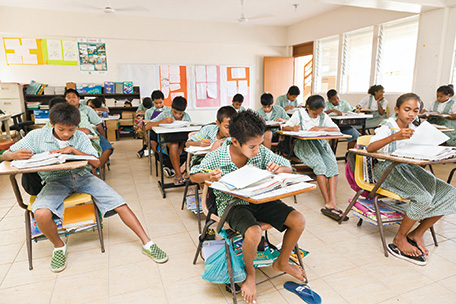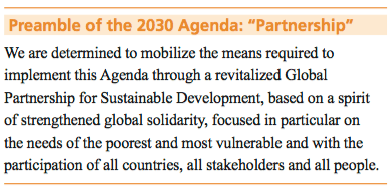Section 2 Overview and Significance of the 2030 Agenda for Sustainable Development
2. Features of the 2030 Agenda
The 2030 Agenda thus identifies broad and diverse goals compared to its predecessor, the MDGs. The 2030 Agenda that embodies this comprehensiveness has a number of features.
Universality

A man creates products at a workshop in a facility for people with disabilities supported by a Japanese NGO in Phnom Penh, Cambodia. (Photo: Shinichi Kuno / JICA)
“Universality” is a key feature of the 2030 Agenda, meaning that the development goals apply to all countries including developed countries, not only developing countries. Indeed, the 2030 Agenda lists many goals concerning issues that face not only developing countries but also developed countries. For example, the goals pertaining to Goal 10’s issue of disparities, Goal 12’s sustainable consumption and production, and Goal 13’s climate action are issues that all countries including developed countries need to address domestically.
Need for cross-cutting approaches
The 2030 Agenda presents a comprehensive set of actions for development, and simultaneously, underlines the inter-linkages between the goals listed by each sector. To implement the 2030 Agenda effectively and efficiently, efforts need to be made to achieve the individual goals and targets, bearing in mind that each issue is not disconnected and that they are closely linked to one another.
For example, in an effort to provide clean water and sanitation (Goal 6), wells or safe and clean toilets may be installed in a community. In turn this can prevent the spread of illnesses (Goal 3: people’s health) and prevent malnutrition caused by diarrhea and other factors (Goal 2: eradicate hunger and improve nutrition, etc.) Furthermore, it can free the community’s girls from having to fetch water, which takes as many as five hours a day, and give them opportunities to attend schools (Goal 4: education). In addition, as is the case in a rural village in India, if women in communities are trained to become repairers of these wells and their revenues then increase, this would also contribute to achieving goals such as eradicating poverty (Goal 1), gender equality (Goal 5), and reduced disparities (Goal 10).
The more that the target goals of development cooperation become diverse and broad, the more important it becomes to pursue consistent and strategic approaches that take into account the “integrated and indivisible” nature of these goals.

People work at a fish market built with aid from Japan in Antigua and Barbuda. (Photo: Kosuke Okahara / JICA)

Pupils study at an elementary school on Ngerekebesang Island in the state of Koror, Palau. (Photo: Kaku Suzuki / JICA)
Focus on the Global Partnership

The Global Partnership is another key feature of the 2030 Agenda. To implement the 2030 Agenda, it is necessary to build a Global Partnership that mutually complements and makes use of a variety of resources, including ODA and private flows, with a range of actors working together such as developed and developing country governments, civil society, and the private sector, by overcoming the traditional North-South dichotomy.
The importance of the Global Partnership is underscored throughout the 2030 Agenda, including in the Preamble (see below). Goal 17 of the SDGs identifies “strengthen the means of implementation and revitalize the Global Partnership for Sustainable Development” as a goal. To this end, the Agenda sets concrete targets, including mobilizing domestic financing through tax and other revenue collection, promoting the transfer of technologies and capacity building in various sectors such as trade and investment, and developing international institutions. Through these efforts, it is expected that the Global Partnership indispensable to the promotion of the 2030 Agenda will be undertaken in a broad context.
